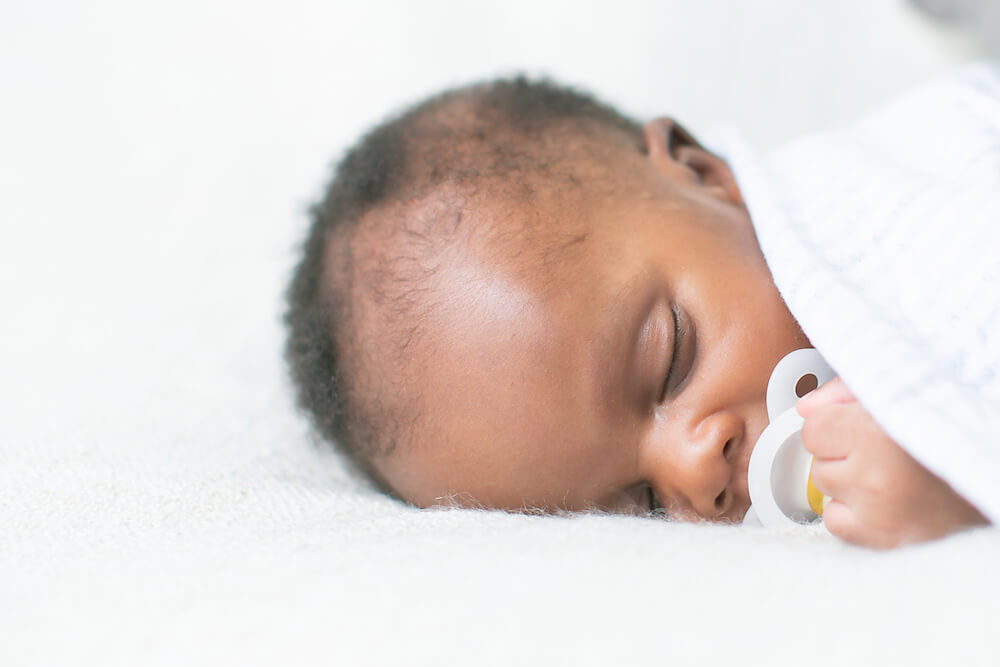When can a baby sleep with a blanket or pillow? Learn how to protect your baby and keep them warm with the safest sleep practices.
If you are like most new parents, you want to make sure your new baby always feels warm, safe, and protected. Watching your baby sleep in their crib or bassinet placed on their backs may have you concerned about their comfort or their warmth.
The urge to “tuck them in” at night can leave you wondering when your baby can sleep with a blanket, or whether they may be more comfortable with a pillow or stuffed animal nearby for comfort. You have almost undoubtedly collected many baby blankets and other bedding accessories as gifts and may be anxiously waiting to use them.
Your pediatrician and other sources have likely expressed the dangers of a baby sleeping with blankets and the increased risk of Sudden Infant Death Syndrome (SIDS) and suffocation.
So when can your baby safely sleep with a blanket? Read on to learn everything you need to know about safe sleeping practices for your little one.
For more guidance on baby sleep, sign up for Dr. Rebecca Spencer’s Masterclass about Baby & Toddler Sleep Essentials to prepare for sleep challenges with your little one.
When Can My Baby Sleep With A Blanket?
According to the American Academy of Pediatrics, healthy babies can sleep with a blanket after their first birthday, with the recommendation of waiting until they are 18 months old.
Babies under the age of 12 months old should be put to sleep flat on their backs on a firm crib mattress that is covered only by a properly sized fitted sheet.
Before the age of one, your baby should be sleeping in a crib or bassinet that is free of all soft bedding materials and other objects. This includes blankets, pillows, stuffed animals, bumper guards, and toys.
Introducing blankets and pillows too early increases the risk of suffocation, strangulation, and SIDS.
Download the Kinedu app to watch expert-led classes on sleep, baby safety, and other relevant topics for parents.
How Do I Keep My Baby Warm While Sleeping Without a Blanket?
If you can’t use blankets for your baby during sleep for at least the first year, you may be wondering how to ensure your little one stays comfortable. The good news is that there are plenty of safe ways to keep your baby warm and cozy during the night or at nap time.
Before you start adding extra layers of clothing or looking into blanket alternatives, it is important to know that the recommended temperature for a healthy and safe sleeping environment is between 68 and 72 degrees Fahrenheit (20-22.2 degrees Celcius) all year long.
Overdressing your baby or using heaters to warm up their rooms can also increase your baby’s risk for SIDS due to overheating. Signs that your baby may be too hot include:
-
- Sweating
- Damp Hair
- Heat Rash
- Flushed Cheeks
- Rapid Breathing
You can use your own comfort to gauge whether or not your little one requires extra layers to sleep comfortably. If it is cooler, and you want to help keep your infant warm at night without using blankets you can safely dress your baby in layers, dress them in footed, warm pajamas, and introduce sleeping sacks.
A sleep sack is a safe, wearable blanket that provides an extra layer of warmth around your baby’s body without any of the dangers posed by blankets, sheets, or comforters.
What Are The Safest Sleeping Practices to Reduce The Risk of SIDS?
Not introducing blankets to your baby before the age of 12 months is just one of the many important sleep practices that can help protect your baby from SIDS. Sudden Infant Death Syndrome is the leading cause of death for babies under 12 months old in the United States.
While there is still no definitive cause for this devastating phenomenon, research has shown that there are ways to significantly reduce your baby’s risk, and many of them involve safe sleeping practices.
Here are the ways you can reduce the risk of SIDS by 50% during sleep according to the American Academy of Pediatrics:
- Your baby should sleep on their back until at least 6 months old, or until they are able to roll over in both directions on their own.
- Put your baby to sleep on a firm crib mattress.
- Do not allow your baby to sleep with pillows, quilts, bumper pads, or stuffed toys.
- Have your baby sleep in a crib or bassinet in your room.
- Consider using a pacifier at nap or bedtime during the first year.
- Do not use any sleeping products that claim to reduce the risk of SIDS like sleep positioners, special mattresses, or other items.
When Can A Baby Sleep With A Pillow?
Now that you know you can safely introduce a blanket to your baby during sleep between 12 and 18 months, you may wonder if that also means your little one can begin sleeping with a pillow as well.
It is recommended that you wait to start having your baby sleep with a pillow until they are a toddler. Specifically, a baby can sleep safely with a pillow once they have successfully transitioned out of their crib and into a toddler bed.
Every child and family will make this transition at different times, but generally, your little one will move into a toddler bed between the ages of 18 months and 3 years. Remember that the longer you wait to provide your toddler with a pillow, the lower the risk of suffocation.
When your baby is ready to sleep with a pillow, it is important to provide them with one that is developmentally appropriate. Adult pillows are too big and are still too soft and malleable.
A toddler pillow is smaller and designed to be firm and safe for your growing child.
Now that you know the answer to the question “When can a baby sleep with a blanket or a pillow?“, be sure to download the Kinedu app to get expert developmental guidance from professionals and experts in early childhood development!








